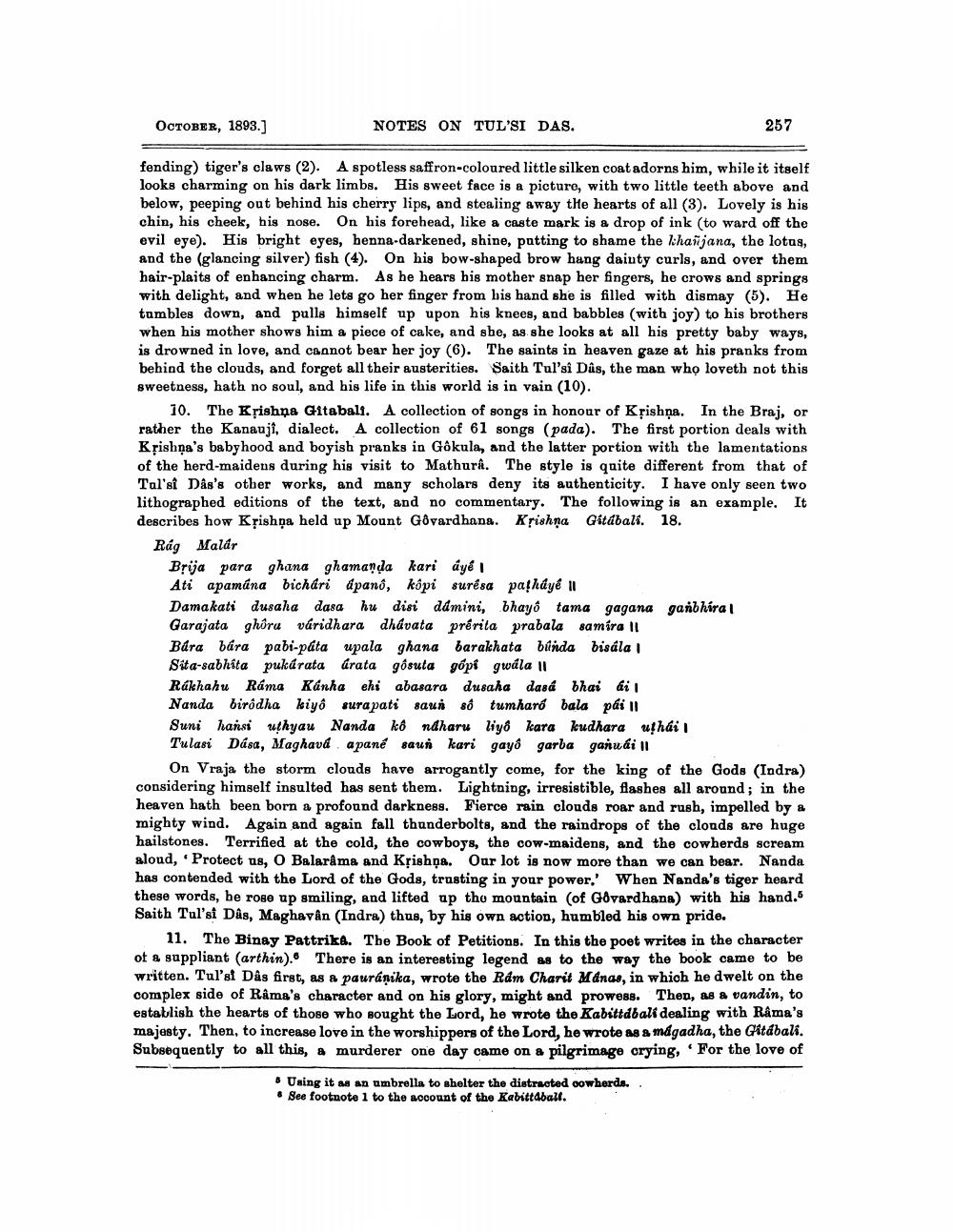________________
OCTOBER, 1893.]
NOTES ON TUL'SI DAS.
257
fending) tiger's claws (2). A spotless saffron-coloured little silken coat adorns him, while it itself looks charming on his dark limbs. His sweet face is a picture, with two little teeth above and below, peeping out behind his cherry lips, and stealing away the hearts of all (3). Lovely is his chin, his cheek, his nose. On his forehead, like a caste mark is a drop of ink (to ward off the evil eye). His bright eyes, henna-darkened, shine, putting to shame the khasjana, the lotus, and the (glancing silver) fish (4). On his bow-shaped brow hang daiuty curls, and over them hair-plaits of enhancing charm. As he hears his mother snap her fingers, he crows and springs with delight, and when he lets go her finger from his hand she is filled with dismay (5). He tambles down, and pulls himself up upon his knees, and babbles (with joy) to his brothers when his mother shows him a piece of cake, and she, as she looks at all his pretty baby ways, is drowned in love, and cannot bear her joy (6). The saints in heaven gaze at his pranks from behind the clouds, and forget all their austerities. Saith Tul'si Dûs, the man who loveth not this sweetness, hath no soul, and his life in this world is in vain (10).
10. The Krishna Gitabali. A collection of songs in honour of Kộishņa. In the Braj, or rather the Kanauji, dialect. A collection of 61 songs (pada). The first portion deals with Krishna's babyhood and boyish pranks in Gokula, and the latter portion with the lamentations of the herd-maidens during his visit to Mathuri. The style is quite different from that of Tol's Das's other works, and many scholars deny its authenticity. I have only seen two lithographed editions of the text, and no commentary. The following is an example. It describes how Krishna held up Mount Govardhana. Krishna Gitdball. 18. Rág Malár
Brija para ghana ghamanda kari aye 1 Ati apamāna bichári ápano, kopi surésa pathdye il Damakati dusaha dasa hu disi admini, bhayo tama gagana ganbhira! Garajata ghôru váridhara dhávata prérita prabala samira 11 Bára bára pabi-pata upala ghana barakhata bunda bisála Sita-sabhita pukárata árata gôsuta gốpi gwála 11 Rákhahu Ráma Kanha ehi abasara dusaha dasá bhai di Nanda birodha hiyo sura pati saun 86 tumharó bala pái II Suni hansi uthyau Nanda ko ndharuliyo kara kudhara uthai Tulasi Dása, Maghavd. apané saun kari gayô garba ganuki 11
On Vraja the storm clouds have arrogantly come, for the king of the Gods (Indra) considering himself insulted has sent them. Lightning, irresistible, flashes all around; in the heaven hath been born a profound darkness. Fierce rain clouds roar and rush, impelled by a mighty wind. Again and again fall thunderbolta, and the raindrops of the clouds are huge hailstones. Terrified at the cold, the cowboys, the cow-maidens, and the cowherds scream aloud, Protect us, o Balarama and Kộishọa. Our lot is now more than we can bear. Nanda has contended with the Lord of the Gods, trusting in your power.' When Nanda's tiger heard these words, be rose up smiling, and lifted up the mountain (of Govardhana) with his hand. Saith Tul'si Das, Maghavan (Indra) thus, by his own action, humbled his own pride.
11. The Binay Pattrika. The Book of Petitions. In this the poet writes in the character of a suppliant (arthin). There is an interesting legend as to the way the book came to be written. Tul's Dås first, as a pauráņika, wrote the Ram Charit Manas, in which he dwelt on the complex side of Râma's character and on his glory, might and prowess. Then, as a vandin, to establish the hearts of those who bought the Lord, he wrote the Kabittdbali dealing with Râma's majesty. Then, to increase love in the worshippers of the Lord, he wrote as & mdgadha, the Gitábali. Subsequently to all this, a murderer one day came on a pilgrimage crying, For the love of
• Using it as an umbrella to shelter the distracted cowherds.. • See footnote 1 to the account of the Kabittball.




